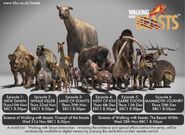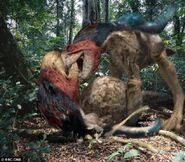(Adding categories) Tag: categoryselect |
No edit summary |
||
| (33 intermediate revisions by 14 users not shown) | |||
| Line 2: | Line 2: | ||
|name = ''Gastornis geiselensis'' |
|name = ''Gastornis geiselensis'' |
||
|att = Horse sized head, tall, large legs, enormous beak |
|att = Horse sized head, tall, large legs, enormous beak |
||
| − | |diet = |
+ | |diet = Omnivorous |
|range = [[Europe]]<br>[[North America]]<br>[[Asia]] |
|range = [[Europe]]<br>[[North America]]<br>[[Asia]] |
||
|time = Late [[Paleocene]] to Early [[Eocene]]<br>56 to 41 MYA |
|time = Late [[Paleocene]] to Early [[Eocene]]<br>56 to 41 MYA |
||
|appearances = ''[[Walking with Beasts]]'': [[New Dawn]]||othern = Diatryma}} |
|appearances = ''[[Walking with Beasts]]'': [[New Dawn]]||othern = Diatryma}} |
||
| ⚫ | |||
| ⚫ | '''''Gastornis''''', also known as '''''Diatryma''''', was a prehistoric neognath [[Birds|bird]]. It was smaller and more robust than the ''[[Phorusrhacos]]'' featured in [[Sabre Tooth]]; it lived 56-41 MYA, during the Paleocene and the early Eocene. Strangely, it's been questioned whether this animal was a herbivore or a carnivore or even an omnivore. |
||
| + | ==<span style="font-size:18px;">Facts</span>== |
||
| ⚫ | These were the largest of birds in the Eocene. Half a ton of feather and muscles and around 2.2 meters tall (larger than the average human being).[[File:Evi gastornis large.jpg|thumb|''Gastornis'' hunting ''[[Leptictidium]]''.]] with a 45 cm skull and beak, shaped like a hatchet. Although the beak's tips weren't hooked, so this bird may have been a herbivore. |
||
| ⚫ | When a female ''Gastornis'' had eggs, only one egg specifically, they had to wait two months for them to hatch. These birds were fiercely territorial and, when another ''Gastornis'' got to close…females moved to protect their nest. Since the great extinction of the non-avian dinosaurs, birds were a success like mammals but, what is more, <span style="font-weight:normal;">they grew big – big enough to take over the role of the large</span> |
||
| ⚫ | |||
| ⚫ | '''''Gastornis''''', also known as '''''Diatryma''''', was a prehistoric neognath [[Birds|bird]]. It was smaller and more robust than the [[Phorusrhacos]] featured in [[Sabre Tooth]]; it lived 56-41 MYA, during the Paleocene and the early Eocene. Strangely, it's been questioned whether this animal was a herbivore or a carnivore or even an omnivore. |
||
| ⚫ | [[File:Gastornis_running.jpg|thumb|left|A Gastornis running through the forest]]<span style="font-weight:normal;">non-avian</span><span style="font-weight:normal;"> </span>dinosaurs. Although '''''Gastornis ''<span style="font-weight:normal;">was the biggest land creature of its time, it had a relatively short neck and thick legs, as opposed to terror birds of later times; in fact, despite the superficial similarities, </span>''Gastornis' ''<span style="font-weight:normal;">closest relatives were ducks and c</span><span style="font-weight:normal;">hic</span><span style="font-weight:normal;">kens, while the terror birds (phorusracids) are actually closely related to cranes, seriemas, etc. Put otherwise, </span>''Gastornis ''<span style="font-weight:normal;">was most likely an ambush predator, while the terror birds had to actively run down their proportionally bigger prey. There are also theories that </span>''Gastornis''<span style="font-weight:normal;"> might have actually been an omnivorous, or even a herbivorous bird, contrary to its depiction in the program.</span>''' |
||
| − | ==Facts== |
||
| ⚫ | These were the largest of birds in the Eocene. Half a ton of feather and muscles and around 2.2 meters tall (larger than the average human being).[[File:Evi gastornis large.jpg|thumb|''Gastornis'' hunting ''[[Leptictidium]]''.]] with a 45 |
||
| − | |||
| ⚫ | When a female ''Gastornis'' had eggs, only one egg specifically, they had to wait two months for them to hatch. These birds were fiercely territorial and, when another ''Gastornis'' got to close…females moved to protect their nest. Since the great extinction of the non-avian dinosaurs, birds were a success like mammals but, what is more, they grew big – big enough to take over the role of the large |
||
| − | |||
| ⚫ | [[File: |
||
==Portrayal in the Series== |
==Portrayal in the Series== |
||
| Line 25: | Line 23: | ||
===''[[Walking with Beasts]]''=== |
===''[[Walking with Beasts]]''=== |
||
====''[[New Dawn]]''==== |
====''[[New Dawn]]''==== |
||
| − | ''Gastornis'' was shown hunting small mammals, such as ''[[Leptictidium]]'' and ''[[Propalaeotherium]]'', and it laid its single egg on the ground, just as the modern flightless birds do. This is why a swarm of giant ants was able to kill and eat the hatchling while the adult ''Gastornis |
+ | ''Gastornis'' was shown hunting small mammals, such as ''[[Leptictidium]]'' and ''[[Propalaeotherium]]'', and it laid its single egg on the ground, just as the modern flightless birds do. This is why a swarm of giant ants was able to kill and eat the hatchling while the adult ''Gastornis'' hunted in another part of the forest. This event foreshadowed the eventual extinction of the ''Gastornis'' species overall: as the global jungle vanished, replaced by a new scrubland (and mangrove) habitat, the giant killer birds (such as ''Gastornis'') vanished, to be replaced by new mammalian carnivores, such as ''[[Hyaenodon]]'' and ''[[Andrewsarchus]]''. |
==Trivia== |
==Trivia== |
||
| − | *Gastornis was widely said to be a carnivore until early 2014, which body structures led scientists classify it as a herbivore, and it's giant beak were hypothesized to crack up plants. |
+ | *''Gastornis'' was widely said to be a carnivore until early 2014, which body structures led scientists classify it as a herbivore, and it's giant beak were hypothesized to crack up plants, but the debate is open, and some scientists say that this bird was omnivorous (eating clams, little animals, roots, big seeds, ...), but until stomach contents are found, no one will know for sure. |
| + | |||
| + | ==Gallery== |
||
| + | <gallery> |
||
| + | Tnt24.info Walking with - Monsters Dinosaurs Beasts Cavemen Eng Subtitles include .6841 438159.jpeg |
||
| + | article-2405749-1B859B6B000005DC-782_634x556.jpg |
||
| + | </gallery> |
||
==Appearances in Other Media== |
==Appearances in Other Media== |
||
| Line 45: | Line 49: | ||
| − | The ''Diatryma'' from Ice Age shares the same colors as the WWB ''Gastornis'', only arranged in a different pattern |
+ | The ''Diatryma'' from Ice Age shares the same colors as the WWB ''Gastornis'', only arranged in a different pattern. Unlike in WWB, they are correctly shown to not be apex predators. |
| − | |||
| − | . |
||
[[Category:Creatures in Walking with Beasts: Operation Salvage]] |
[[Category:Creatures in Walking with Beasts: Operation Salvage]] |
||
[[Category:Creatures]] |
[[Category:Creatures]] |
||
| Line 53: | Line 55: | ||
[[Category:Terrestrial creatures]] |
[[Category:Terrestrial creatures]] |
||
[[Category:Carnivorous creatures]] |
[[Category:Carnivorous creatures]] |
||
| ⚫ | |||
[[Category:Birds]] |
[[Category:Birds]] |
||
[[Category:Creatures from North America]] |
[[Category:Creatures from North America]] |
||
| Line 62: | Line 65: | ||
[[Category:Creatures from the Eocene]] |
[[Category:Creatures from the Eocene]] |
||
[[Category:Minor animals]] |
[[Category:Minor animals]] |
||
| ⚫ | |||
| ⚫ | |||
| ⚫ | |||
[[Category:Carnivores]] |
[[Category:Carnivores]] |
||
| + | [[Category:Vertebrates]] |
||
| ⚫ | |||
| ⚫ | |||
| + | [[Category:New Dawn]] |
||
| + | [[Category:Feathered animals]] |
||
| + | [[Category:Eocene Animals]] |
||
| + | [[Category:Long necked animals]] |
||
| + | [[Category:Paleocene Animals]] |
||
| + | [[Category:Paleogene animals]] |
||
| + | [[Category:Cenozoic animals]] |
||
Revision as of 22:46, 6 September 2020
| “ | This is a world where birds eat horses. | ” |
Gastornis, also known as Diatryma, was a prehistoric neognath bird. It was smaller and more robust than the Phorusrhacos featured in Sabre Tooth; it lived 56-41 MYA, during the Paleocene and the early Eocene. Strangely, it's been questioned whether this animal was a herbivore or a carnivore or even an omnivore.
Facts
These were the largest of birds in the Eocene. Half a ton of feather and muscles and around 2.2 meters tall (larger than the average human being).
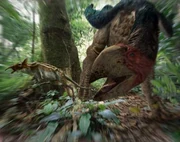
Gastornis hunting Leptictidium.
with a 45 cm skull and beak, shaped like a hatchet. Although the beak's tips weren't hooked, so this bird may have been a herbivore.
When a female Gastornis had eggs, only one egg specifically, they had to wait two months for them to hatch. These birds were fiercely territorial and, when another Gastornis got to close…females moved to protect their nest. Since the great extinction of the non-avian dinosaurs, birds were a success like mammals but, what is more, they grew big – big enough to take over the role of the large
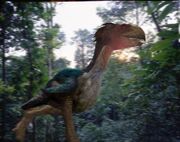
A Gastornis running through the forest
non-avian dinosaurs. Although Gastornis was the biggest land creature of its time, it had a relatively short neck and thick legs, as opposed to terror birds of later times; in fact, despite the superficial similarities, Gastornis' closest relatives were ducks and chickens, while the terror birds (phorusracids) are actually closely related to cranes, seriemas, etc. Put otherwise, Gastornis was most likely an ambush predator, while the terror birds had to actively run down their proportionally bigger prey. There are also theories that Gastornis might have actually been an omnivorous, or even a herbivorous bird, contrary to its depiction in the program.
Portrayal in the Series
Gastornis was portrayed as the apex predator of the Early Eocene rainforests. It only laid one egg at a time. Because of its size and flightlessness, it made its nests on the ground, where its eggs and hatchlings were vulnerable to various predators.
In the Walking With series
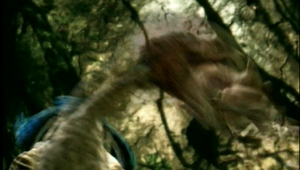
Gastornis as it appears in the intro
Walking with Beasts
New Dawn
Gastornis was shown hunting small mammals, such as Leptictidium and Propalaeotherium, and it laid its single egg on the ground, just as the modern flightless birds do. This is why a swarm of giant ants was able to kill and eat the hatchling while the adult Gastornis hunted in another part of the forest. This event foreshadowed the eventual extinction of the Gastornis species overall: as the global jungle vanished, replaced by a new scrubland (and mangrove) habitat, the giant killer birds (such as Gastornis) vanished, to be replaced by new mammalian carnivores, such as Hyaenodon and Andrewsarchus.
Trivia
- Gastornis was widely said to be a carnivore until early 2014, which body structures led scientists classify it as a herbivore, and it's giant beak were hypothesized to crack up plants, but the debate is open, and some scientists say that this bird was omnivorous (eating clams, little animals, roots, big seeds, ...), but until stomach contents are found, no one will know for sure.
Gallery
Appearances in Other Media
Video Games
Read more at the Jurassic Park Wiki
Read more at the Jurassic Park Builder Wiki
Read more at the Scribblenauts Wiki
Gastornis' design in WWB was reused for the video games Jurassic Park Builder and the Scribblenauts series.
Ice Age
Read more at the Ice Age Wiki
The Diatryma from Ice Age shares the same colors as the WWB Gastornis, only arranged in a different pattern. Unlike in WWB, they are correctly shown to not be apex predators.

